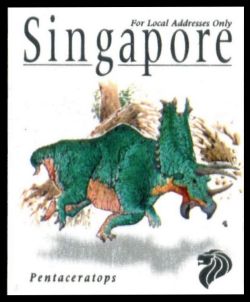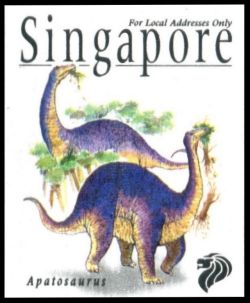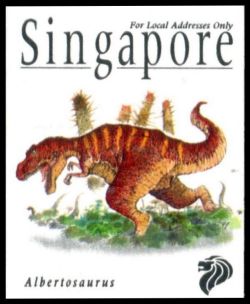Singapore 1998 "Dinosaurs - animals that once ruled the Earth"
| <prev | back to index | next> |
| Issue Date | 22.04.1998 |
| ID | Michel: 874-876; Scott: 831-833; Stanley Gibbons: 916-918; Yvert: 846-848; Category: pR |
| Design | Designer: Nicodemus Loh, Graphic designer: Elsie Koh |
| Stamps in set | 3 (self-adhesive ATM) |
| Value | No value indicator, for local post only (22c): Pentaceratops Apatosaurus Albertosaurus |
| Emmision/Type | commemorative |
| Places of issue | Singapore |
| Size (width x height) | stamps: 24.67mm x 31.2mm Sheet size: 74mm x 156mm, 0.13mm thin |
| Layout | 15 stamps per sheet |
| Products | FDC x 1, MS x1 |
| Paper | Unwatermarked |
| Perforation | Die-Cut (imperforated) |
| Print Technique | Rotogravure |
| Printed by | Avery Dennison |
| Quantity | 7,500,000 |
| Issuing Authority | Singapore Post |
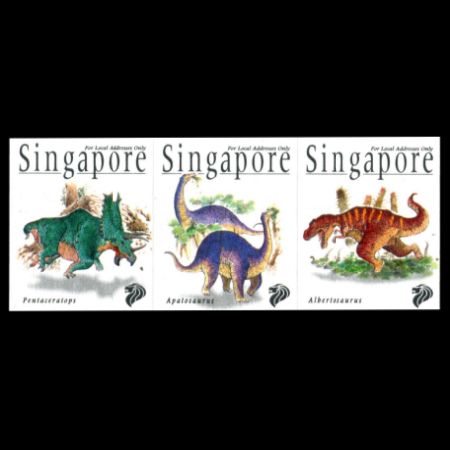
On April 22nd, 1998, the Post of Singapore issued three self-adhesive stamps depicting dinosaurs.
These stamps, without face values, were valid for local mail (as inscribed on the top side of every stamp) up to 20gr. or for part payment for postage on heavier items.
These stamps could not be used on overseas mail. It seems, however, after several years, the rule was recalled - see some cover examples with these stamps sent to Germany in 2012.
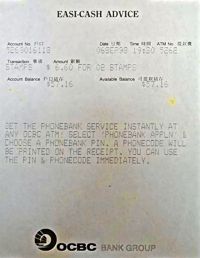
|
| The receipt of Oversea Chinese Banking Corporation. |
At the beginning, the sheet of 15 stamps was sold by Singapore Post's philatelic bureaus as well as
via OCBC (Oversea Chinese Banking Corporation) ATMs.
The sheet was designed with exactly the same dimensions as the currency note of SGD 50 (156mm x 74mm x 0.13mms),
so that they can be issued through the same aperture.
(New notes with different dimensions were issued in 1999).
These stamps are the thinnest stamps related to Paleontology.
Later on the sale through ATM machine was abandoned, due to frequent jamming of these sheetlets
and the stamps were offered to collectors in the philatelic bureau only.
During that period, two different designs of the reverse side
of the sheet were issued (the brown one is less common).
The First Day Cover (FDC) was on sale at select Singapore Post's philatelic bureaus only,
since the date of the stamps issue.
Dinosaurs are probably the best-known prehistoric life. [Note]
Their dynasty started 230 million years ago, in the Mesozoic Era, from the Late Triassic until the end of Cretaceous, a total of 165 million years.
Two groups of dinosaurs existed, the Saurischian (or lizard-hipped dinosaurs) and the Ornithischian (or bird-hipped dinosaurs) and they can be plant or meat-eaters.
Many myths and legends have been told about the dinosaurs. Some are based on facts, others no more than guess work.
The three dinosaurs featured here are from different family groups and lived in different periods.
Fossil finds show that all lived in North America during the Mesozoic.
Note: The text above was provided on a leaflet inside official FDC.
According to todays knowledge, some statements above might be obsolete.
For example:
- Technically, the dynasty hasn’t ended yet. Nowadays, paleontologists assign birds to Avian dinosaurs, the prehistoric dinosaurs called Non-avian dinosaurs in recent scientific books and articles.
-
The Ornithischian dinosaurs are thought to only be herbivores (plant-eaters).
The Theropods were mostly carnivores – but there are a few interesting groups from the Cretaceous that may have been omnivores or herbivores.
The Saurischians were mixed. Some of the early prosauropods were likely omnivores and a few have even been interpreted as carnivores. Their larger relatives – the apatosaurus/brachiosaurus, etc. were definitely herbivores. The Theropods were mostly carnivores – but there are a few interesting groups from the Cretaceous that may have been omnivores or herbivores.
Products and associated philatelic items
| Mini Sheet (the MS is available with two different back sides, the brown one is less common.) | FDC (Inside text is here) | |
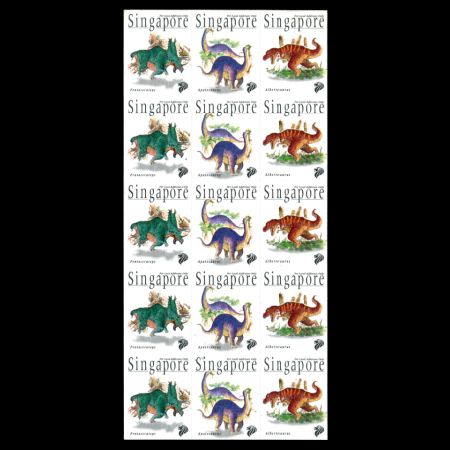 |
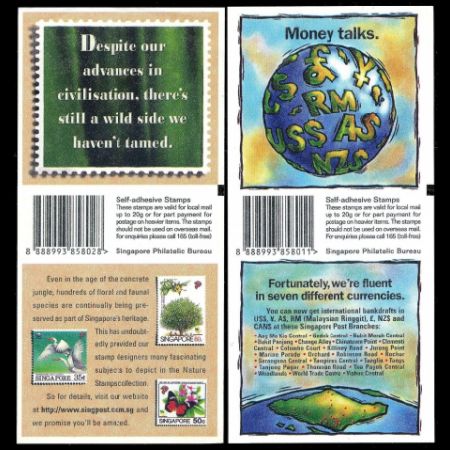 |
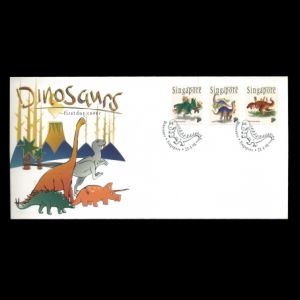 |
| Examples of circulated covers | First-Day-of-Issue Postmark | |
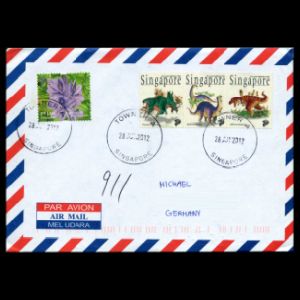 |
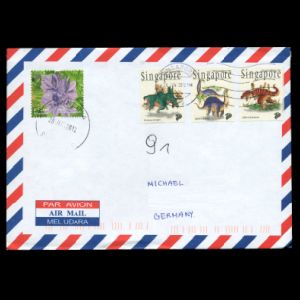 |
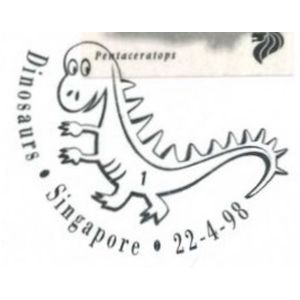 |

|
References
Leaflet of official FDC, personal communication with some philatelist from Singapore.Acknowledgements
- Many thanks to fellow stamp collectors Ai Lyn Lim and Eddie Yong from Singapore, for their help finding information about these stamps.
- Many thanks to Dr. Peter Voice from Department of Geological and Environmental Sciences, Western Michigan University, for reviewing the draft page and his very valuable comments.
| <prev | back to index | next> |
